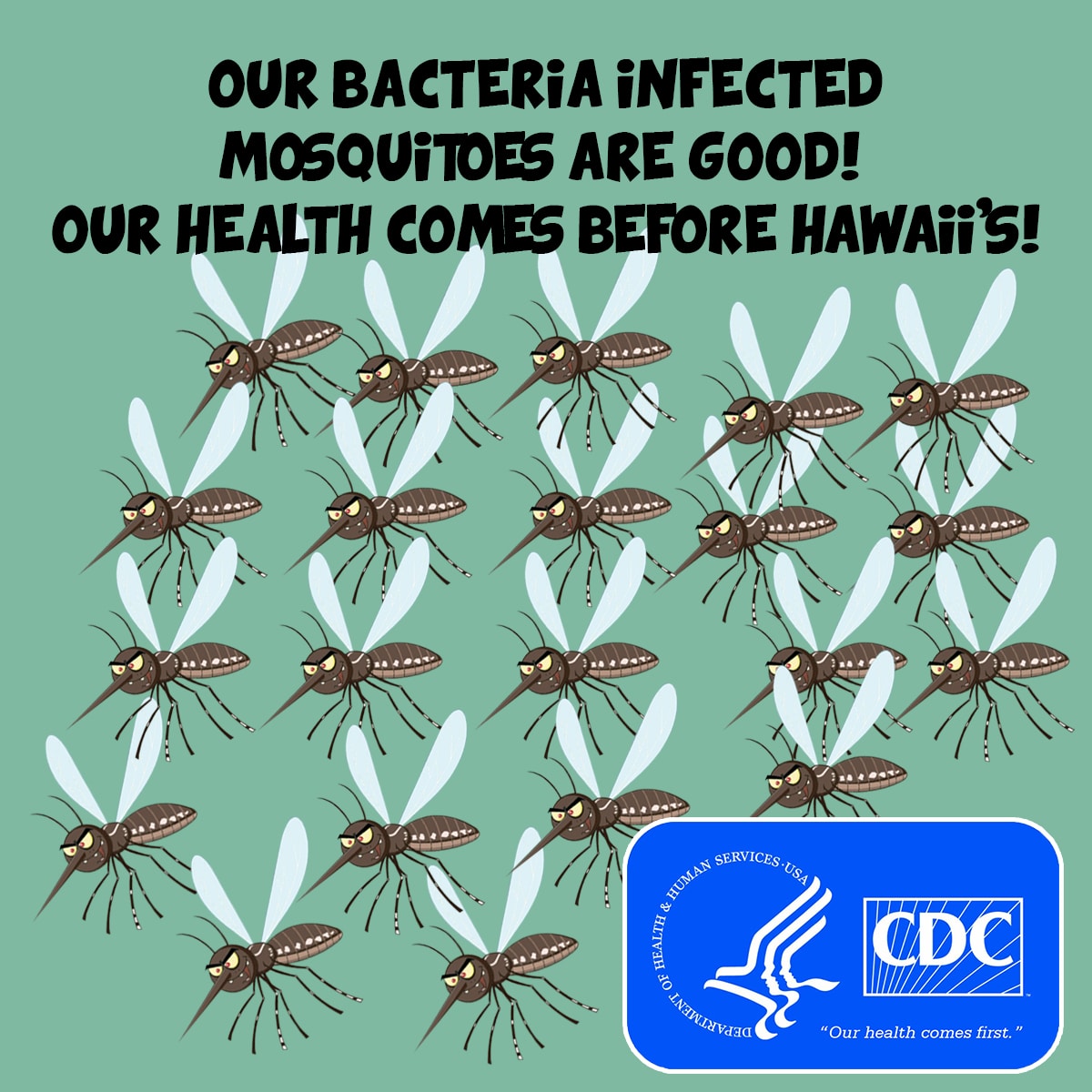

Mosquito Court Case Update: Reply Brief Filed in Our Appeal
by Hawaii Unites | Sep 27, 2024
At the beginning of this year, Hawai‘i Unites’ case to stop the mosquito releases on Maui and require an environmental impact statement was in the process of discovery as we prepared for our trial scheduled to begin in July, 2024. The hearing on our Motion for Temporary Restraining Order and Preliminary Injunction had already begun in July 2023 and was scheduled to continue the following month. Due to the tragic Maui fires in August 2023, that hearing was postponed. As we awaited rescheduling of our hearing and continued preparing for our scheduled trial, the state agency defendants filed a motion for summary judgment requesting that the court decide our case without going to trial.
In January, First Circuit Court Judge John M. Tonaki issued an order granting the State of Hawai‘i defendants’ motion for summary judgment, which stopped our case against the State of Hawai‘i Department of Land and Natural Resources (DLNR) and Board of Land and Natural Resources (BLNR) from going to trial in July as scheduled. This also meant that we didn’t receive discovery documents and admissions that were due the same week as the judge’s decision.
In March, we filed an appeal in the Hawai‘i State Judiciary Intermediate Court of Appeals (ICA). We’re seeking a ruling that our case be remanded back to the circuit court and go to trial. This case is strong, and we’re ready to present our arguments in the courtroom. We are standing up to strengthen environmental laws for all islands and protect the health of Hawai‘i’s people, wildlife, and ‘āina from this dangerous biotech mosquito experiment.
We believe the judge’s ruling granting summary judgment is flawed, and we’ve outlined several issues with the ruling in our opening brief for the appeal. Last week, we filed our reply brief in response to the State defendants’ answering briefs. Our points of error were again outlined.
First, we assert that the Circuit Court erred by applying the wrong standard for reviewing the sufficiency of an environmental assessment (EA). The “rule of reason” standard applied is only appropriate for the review of an environmental impact statement (EIS).
“In fact, there are several reasons why the same standard should not apply, not least of which is that Hawai‘i courts have held that in cases reviewing the sufficiency of an environmental assessment and whether an EIS is required, the ‘clearly erroneous’ standard is the correct standard to use.”
Further, the court erred in granting summary judgment when there are material facts in dispute.
“In the instant case, there are numerous facts in dispute, including the efficacy and safety of the experimental ‘Incompatible Insect Technique’ (IIT) planned for use in the project and the ability of Wolbachia bacteria in mosquitoes to cause increased pathogen infection and to cause mosquitoes to become more capable of spreading diseases such as avian malaria and West Nile virus.”
Additionally, because of the undisputed failure of the DLNR to comply with Hawai‘i Administrative Rules in preparing its final environmental assessment (FEA), the agency record does not reflect clear and complete findings.
“The failure of State Defendants to follow HAR § 200.1-20 by itself demonstrates that the Circuit Court applied the wrong standard.”
Accepting the deficient FEA was clearly erroneous.
“Defendant BLNR simply took Defendant DLNR’s word that the ‘Birds Not Mosquitoes’ (BNM) project would not have any significant impact and approved the FEA/FONSI [Finding of No Significant Impact] instead of taking a ‘hard look’ at the information presented and giving serious consideration to the impacts as required by chapter 343.”
“Contrary to State Defendants’ assertion that the IIT technique is not new, and not the first time it has been used for control of mosquitoes as disease vectors (AB at pg. 8), this project is an experiment, and this specific Wolbachia IIT technique has never been documented as used for control of mosquitoes as disease vectors.”
“…Plaintiffs raise serious questions regarding facts in dispute and concerns that were not addressed at all in the FEA, including Environmental Protection Agency (‘EPA’) guidelines allowing for the release of one female mosquito for every 250,000 males; the fact that Wolbachia bacteria is parasitic, and parasitic organisms can alter the behavior of the hosts they live inside; and the possibilities of biopesticide drift or wind drift, or the movement of the lab-bred mosquitoes through wind to unintended areas…”
“…the fact remains that Birds, Not Mosquitoes agency partners have not conducted any studies on the risks or potential significant impacts of the specific species of mosquito infected with the specific strain of Wolbachia being released in Hawai‘i’s fragile ecosystems.”
“…the final EA’s assertion that released mosquitoes pose no risk to human health is based on unsound science, and the unintended consequences of a project of this scale resulting in the unintended spread of the imported Wolbachia strain(s) to female Culex or Aedes mosquitoes or other insect vectors of diseases could be catastrophic and likely irreversible.”
“…Defendants go so far as to ask ‘[w]hat difference would it make if mosquitos could mate twice in their life rather than once…?’ AB at pg. 18. Perhaps the agency should have concerned itself with that same question in the EA… [P]er the declaration of tropical disease and vector expert Dr. Lorrin Pang, a second mating could result in viable offspring with the lab-strain bacteria…”
“…per the declaration of Dr. Pang, Wolbachia bacteria can transfer between male mosquitoes and female mosquitoes through horizontal transmission…”
The FEA also failed to provide alternatives to the proposed action.
“To be clear, Wolbachia IIT is not the only viable option, and several alternatives have not been considered, including Dr. Lorrin Pang’s alternative approach of treatment of avian malaria in the mosquito phase through antimalarial drug feeding.”
“The alternative approach of biological larvicide controls, an alternative considered and dismissed in the FEA, is currently being used in the project area in combination with the release of Wolbachia IIT mosquitoes. Aerial spraying of BTI bacterial larvicide is now considered by Birds, Not Mosquitoes agencies to be a viable option, though not part of the approved plan. This reaffirms that alternatives were not sufficiently considered in the FEA.”

Our second point of error is that the Circuit Court erred in granting summary judgment based on a failure to address additional material facts.
“Additional material facts discovered since the filing of the Complaint, including release by helicopters rather than drones, use of a short tube instead of the stated longline release, and additional fire risks from 12V batteries that were not studied or discussed in the FEA, [suggesting] a project being carried out in a manner contrary to what was proposed, explained, and/or studied in the FEA should have given the Circuit Court pause and further demonstrate that the granting of summary judgment was premature, coming before discovery had been completed and thus was inappropriate at that juncture.”
In our third point of error, we detail how acceptance of the FEA was a violation of Hawai‘i Revised Statutes (HRS Chapter 343) and of Hawai‘i Administrative Rules (HAR § 11-200.1-20).
“Plaintiffs have repeatedly asserted that not only did Defendant DLNR fail to follow administrative rules and Defendant BLNR violate the letter and purpose of HEPA [Hawai‘i Environmental Policy Act] by issuing a FONSI based on a flawed document, but that Plaintiffs’ serious concerns about the risks and potential significant impacts of the mosquito release experiment have not been adequately addressed, and that several concerns have not been addressed at all. Additionally, there is no way to know if specific concerns are being addressed when the concerns of multiple commenters are combined together, altered, not identified with the names of commenters, and not appended in full to the FEA.”
We conclude by respectfully requesting that the ICA reverse the Circuit Court’s decision and remand the case for further proceedings. The Intermediate Court of Appeals will now decide.
“Once the parties have completed the process of briefing the appeal, the appeal is submitted to a merit panel, which is comprised of three randomly selected ICA judges. The merit panel reviews and considers the briefs filed by the parties, relevant records of the court or agency appealed from, and relevant transcripts of proceedings prepared for the appeal. The merit panel decides the case by applying the relevant law to the facts of the case.”
“Generally, the ICA decides cases based on the written briefs. On occasion, the ICA will hear oral (spoken) argument.”
While the BNM agencies pushing these mosquito releases on our island home continue to mislead the people by presenting incomplete, unsubstantiated, and false information, Hawai‘i Unites will continue to document the truth about this dangerous experimental project. We have a strong appeal, and we’re hopeful that our environmental court case will get to trial.
Mahalo to everyone standing with us as we face this David and Goliath battle to protect the ‘āina from biotech industry experimentation. We’re up against a heavily funded multi-agency partnership with a slick propaganda campaign and long-term goals of milking this cash cow into perpetuity by selling out these sacred lands for use as testing grounds.
Please share this update, help raise awareness about the risks of this lab-altered mosquito release agenda, and support the work that we’re doing by making a tax-deductible donation today.
Aloha,
Tina Lia
Founder
Hawai‘i Unites
HawaiiUnites.org



